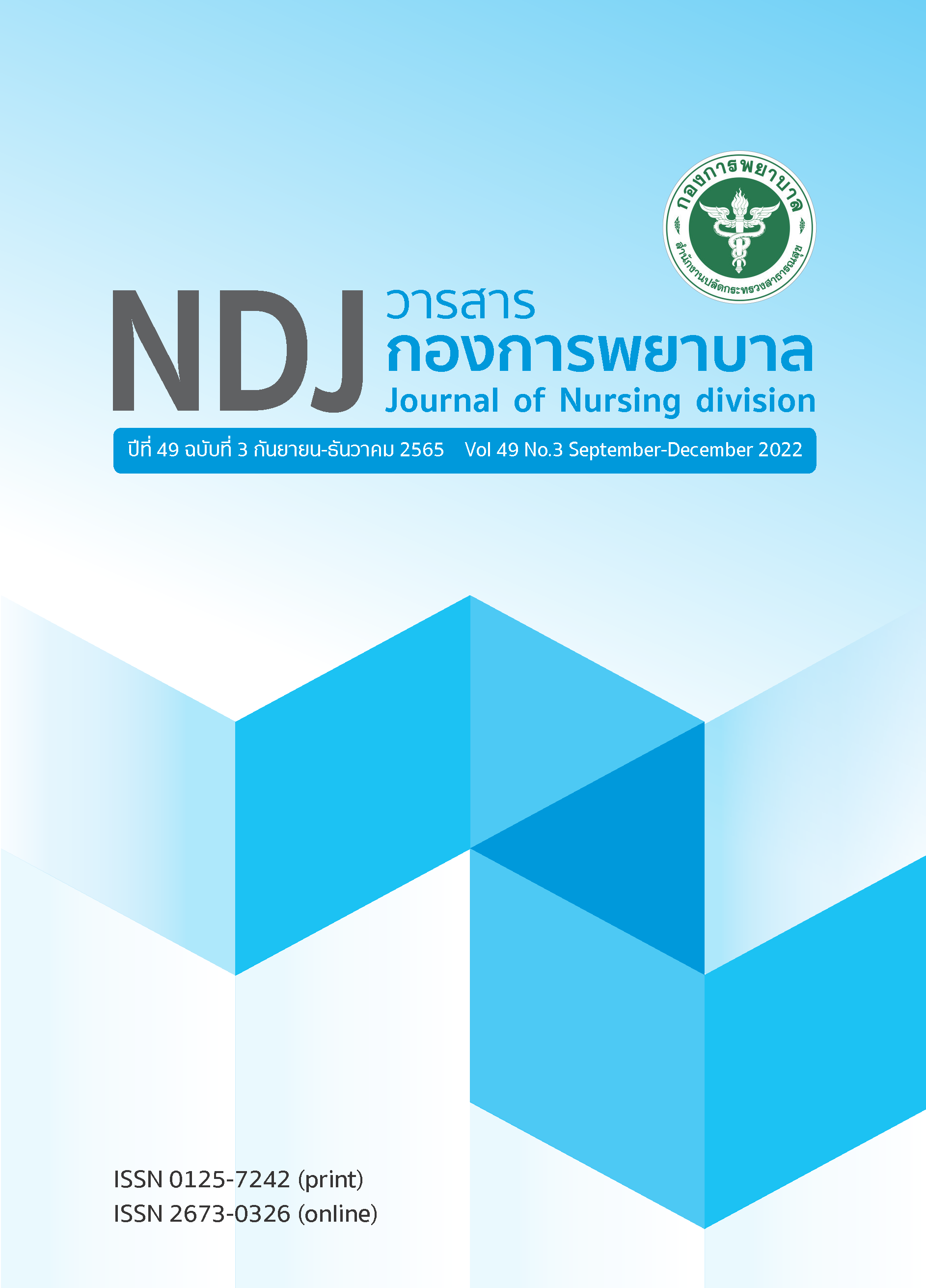การพัฒนาแนวปฏิบัติการพยาบาลผู้ป่วยศัลยกรรมที่มีภาวะติดเชื้อในกระแสโลหิต แบบรุนแรงจากชุมชน ที่เข้ารับการรักษาในห้องผู้ป่วยหนักศัลยกรรม โรงพยาบาลสระบุรี
Main Article Content
บทคัดย่อ
วัตถุประสงค์ของการวิจัยและพัฒนาครั้งนี้ คือ พัฒนาและศึกษาผลลัพธ์การใช้แนวปฏิบัติการพยาบาลผู้ป่วยศัลยกรรมที่มีภาวะติดเชื้อในกระแสโลหิตแบบรุนแรง ดำเนินการ 4 ขั้นตอน (1) การวิเคราะห์สภาพการณ์ (2) การพัฒนาแนวปฏิบัติ (3) การใช้แนวปฏิบัติ (4) การประเมินผล เลือกกลุ่มตัวอย่างแบบเจาะจง คือ พยาบาลวิชาชีพ จำนวน 30 คน และ ผู้ป่วยศัลยกรรมที่มีภาวะติดเชื้อในกระแสโลหิตแบบรุนแรง จำนวน 72 คน เครื่องมือดำเนินการวิจัย คือ แนวปฏิบัติการพยาบาล ค่า IOC 0.93 และคู่มือการปฏิบัติ ค่า AGREE II ร้อยละ 89.72 เครื่องมือเก็บข้อมูล ได้แก่ แบบทดสอบความรู้ ค่า KR-20 คือ 0.81 แบบตรวจสอบการปฏิบัติ และบันทึกผลลัพธ์ทางคลินิก ค่า IOC 0.93 และ 0.95 ตามลำดับ ค่าสัมประสิทธิ์อัลฟาครอนบาคของแบบประเมินสมรรถนะ และความเห็นของพยาบาลวิชาชีพ 0.89 และ 0.84 ตามลำดับ วิเคราะห์ข้อมูลด้วยสถิติเชิงพรรณนา t-test และ Fisher’s exact test
ผลการวิจัย พบว่า แนวปฏิบัติการพยาบาลผู้ป่วยศัลยกรรมที่มีภาวะติดเชื้อในกระแสโลหิตแบบรุนแรง มี 11 หมวด (1) การประเมินและเฝ้าระวัง (2) การพยาบาลผู้ป่วยติดเชื้อในกระแสโลหิตแบบรุนแรง (3) การพยาบาลระบบทางเดินหายใจ (4) การพยาบาลผู้ป่วยก่อนและหลังผ่าตัด (5) การเคลื่อนย้ายผู้ป่วยระยะวิกฤต (6)) การป้องกันภาวะแทรกซ้อน (7) การส่งเสริมภาวะโภชนาการ (8) การลดความวิตกกังวล (9) การฟื้นฟูสุขภาพ (10) การวางแผนจำหน่าย (11) บันทึกทางการพยาบาล หลังใช้แนวปฏิบัติฯ พยาบาลวิชาชีพมีการปฏิบัติ มีสมรรถนะ และมีความรู้เพิ่มขึ้นอย่างมีนัยสำคัญทางสถิติ (p < .05) ผู้ป่วยได้รับยาต้านจุลชีพภายใน 1 ชั่วโมงเพิ่มขึ้น นอกจากนี้ การติดเชื้อที่แผลผ่าตัด จำนวนวันนอนเฉลี่ยใน ICU ค่ารักษาพยาบาล และอัตราการเสียชีวิตลดลง และไม่พบอุบัติการณ์ติดเชื้อในกระแสโลหิต
Article Details

อนุญาตภายใต้เงื่อนไข Creative Commons Attribution-NonCommercial-NoDerivatives 4.0 International License.
เอกสารอ้างอิง
References
World Health Organization. The World Health Organization’s first global report on sepsis. [internet]
[cited 2021 Oct 5]; Available from https://www.who.int/news/item/08-09-2020-who-calls.
Health Data Center, Ministry of Public Health. [internet]. 2021 [cited 2021 Oct 5]; Available from
https://hdcservice.moph.go.th/hdc/reports/report.php?source. Thai.
Saraburi Hospital, (2021), annual performance report 2021. Thai.
Hanlumyuang G. The analysis of contributing factors to septic death in Pakkred Hospital. Journal
of Preventive Medicine Association of Thailand. 2020;10(1):108-117. Thai.
Charoenpong L, Pholtawornkulchai K. Incidence and risk factors associated with mortality from sepsis At Chaophrayayommarat Hospital. Region 4-5 Medical Journal. 2020;39(4):542-560. Thai.
Nawijn F, Smeeing DPJ, Houwert RM, Leenen LPH, Hietbrink F. Time is of the essence when treating
necrotizing soft tissue infections: a systematic review and meta-analysis. Word Journal of Emergency
Surgery. 2020;15(4):1-11.
Abaziou T, Vardon-Bounes F, Conil's JM, et al. Outcome of community- versus hospital-acquired
Intra-abdominal infections in intensive care unit: a retrospective study. JMA Anesthesiol. 2020;20(1):
- 303.
Tellor B, Skrupky LP, Symons W, et al. Inadequate source control and inappropriate antibiotics are
key determinants of mortality in patients with intra-abdominal sepsis and associated bacteremia.
Surgical Infection. 2015;16(6):785-793.
Surgical intensive care unit Saraburi Hospital, (2021), Annual performance report 2021. Thai.
Thiemsuwan Y, Orachon O, Yindesuk T, Kwanchang P, Prasertsri N. The Development caring system
of critical sepsis patients by case management at Sunprasithtiprasong Hospital, Ubon Ratchathani.
Journal of Nursing and Health Care. 2017;35(1):184-193.
Apiradeewageeset N, Karnchanasint P. Nursing care of adult severe sepsis/ septic Shock Siriraj
Hospital. [internet]. 2013. [cited 2021 Oct 7]; Available from https://www.google.com/search?q +severe+sepsis%2Fseptic+shock. Thai.
Kusoom W, editor. Critical care nursing: A holistic approach. 6th ed. Bangkok: Sahap-rachapanich;
(in Thai)
Evans L, Rhodes A, Alhazzani W, et al. Surviving sepsis campaign: International guidelines for
management of sepsis and septic shock 2021. Critical Care Medicine. 2021;49(11): e1063-e1143.
National Health and Medical Research Council (NHMRC). A guide to the development,
Implementation and evaluation of clinical practice guidelines. [internet]. 1988. [cited 2021 Oct 10];
Available from https://www.nhmrc.gov.au/ guidelines-publications/cp30.
Bandura A. The Social Cognitive Theory. [internet]. 1986. [cited 2021 Oct 10]; Available from
https://sphweb.bumc.bu.edu/otlt/mph-modules/sb/behavioralchangetheories.
Spross J A, Expert coaching and guidance. Advanced nursing practice: An integrative approach.
St. Louis: Saunders Elsevier:159-90.
Gaesawahong R, Saengpattrachai M. Coaching for nurse leadership competency development.
Thai Journal of Nursing and Midwifery Practice. 2022;9(1):122-128.Thai.
Al Omar S, Khalaf I, Alshraideh J.A. Implementing surviving sepsis campaign guidelinesand mortality of
adult patients in intensive care units: An integrative review. Open Journal of Nursing. 2019;9(10):
-1072.
Phongpattanawoot U, Suttana S, Sanpunya T. Development of the nursing service system for patients
with sepsis Phrae Hospital. Journal of Nursing Division. 2022;122(8):84-95.
Choy CL, Liaw SY, Goh EL, See KC and Chua WL. Impact of sepsis education for healthcare
professionals and students on learning and patient outcomes: a systematic review. [internet].
[cited 2022 Feb. 10]; Available from https:// www.sciencedirect. com/science/article/ pii/
S0195670122 000093.
Nueng Nasuwan W, Normkusol J, Thongjam R, Panaput T. Development of the nursing service system for patients with severe sepsis. Thai Journal of Nursing and Midwifery Practice. 2019;6(1): 36- 51.
Chaokhamin T, Pearkao C, Pho-ong J, Phumchumseang P. Development of clinical nursing practice
guideline for patients with severe traumatic brain injury at surgical intensive care unit in Saraburi
Hospital. Journal of Nursing Division. 2018;45(2):5-28. Thai.
Tannukit P, Sukthongsa D. Central line associated blood stream infection care: a case study. 2019.


